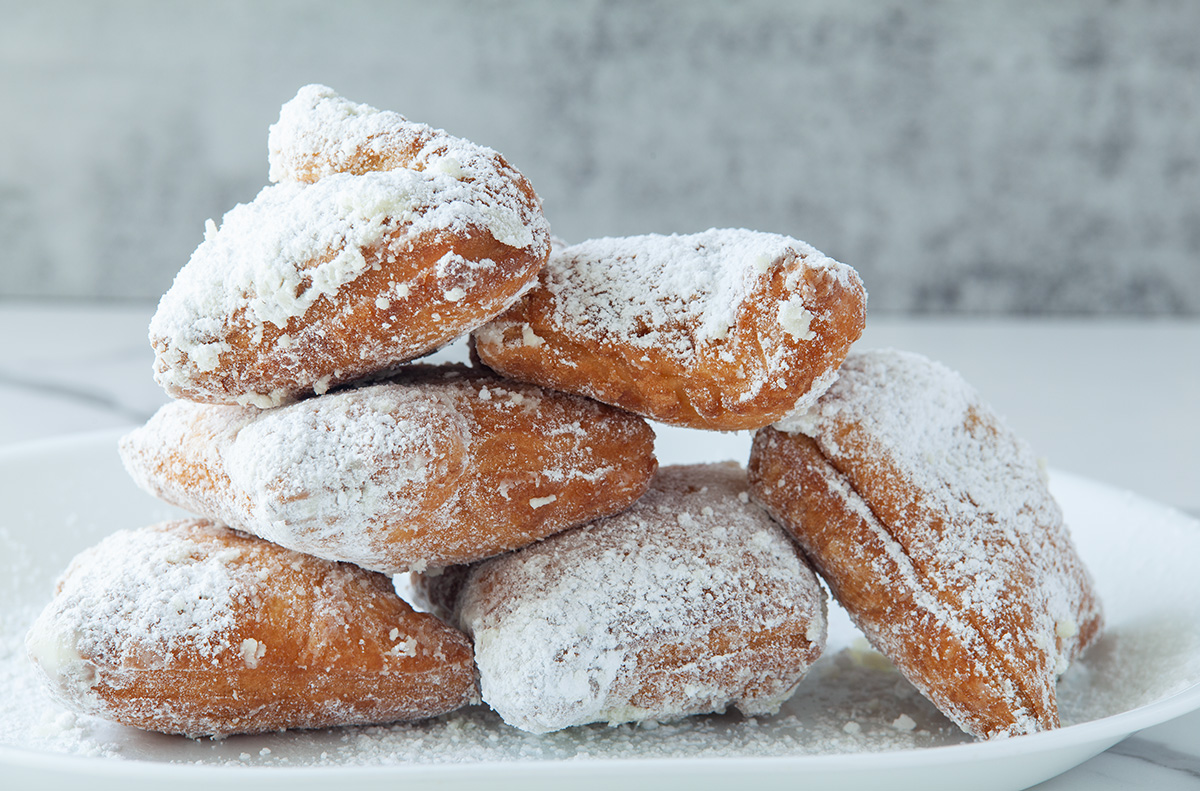Beignets
Beignets, or pockets of fried dough served with powdered sugar, are an iconic New Orleans treat.

The Louisiana Endowment for the Humanities
Beignets covered in powdered sugar, 2023. Melissa Carrier, photographer.
Beignets are arguably the sweet treat most associated with New Orleans. In the words of food writer Sara Roahen, they are “dense, rectangular, yeast-risen pockets of fried dough on which powdered sugar has been dumped in amounts that call to mind an avalanche.” Enjoying a plate of golden-crisp beignets—always three to an order—is a rite of passage for most every New Orleanian, while a trip to Café du Monde’s original Decatur Street location to sample the pastry tops the to-do list of many visitors to the city.
Louisiana’s beignet is derived from the French, where the word means literally bump, likely because of the way the dough puffs, or bumps, up when fried in hot oil. In France today, the term beignet most often describes a puffed fritter made from frying pâte à choux, a hot water pastry made from flour, butter, and eggs.
Beignets likely came to New Orleans via French-speaking colonists—whether from France, French-Canada, or the Caribbean—in the eighteenth century. Further speculations about local origins are mere conjecture.
Café du Monde opened in the Butcher’s Hall section of the New Orleans French Market in 1862. Fred Koeniger’s business was one of the market’s many coffee stands, places where butchers, with their early work schedule, could score a much-needed caffeine jolt. It is unclear when fried dough was added to the menu. By the century’s turn, the Picayune Creole Cook Book (first edition, 1900) included several recipes for beignets, under the subject heading “Fritters,” and are described as traditionally served “piled with snowy sugar.”
By the 1920s, Café du Monde and a neighboring French Market coffee stand named Morning Call, founded in 1870 by Croatian immigrant Joseph Jurisich, were well known for serving up what we would today call beignets, but were then sold morning, noon, and night as “doughnuts.”
“There aren’t any holes in them, they are not round like in the conventional doughnut,” the Times-Picayune reported on August 22, 1927. “They aren’t anything that an ordinary doughnut is. The reason is that they are better. There is just about as much comparison between the so-called doughnuts at the Morning Call and the usual true species of doughnut that everybody knows. ¼ To eat the doughnuts at the Morning Call is to remember them a lifetime. They are that good. And they aren’t made quite so good anywhere else in the world.”
But with an increased turn toward tourism by mid-century, French Market coffee shops rebranded their doughnuts as beignets. “The good old doughnut has gone cultural on us,” a Times-Picayune columnist wrote in 1958. On July 3, 1964, the day after President Lyndon Johnson signed the Civil Rights Act, Café du Monde served its first Black customers.
Today, Café du Monde is open twenty-four seven. During its busiest hours, a long line of beignet and chicory café au lait devotees and first timers wait under the iconic green-and-white-striped awning. After relocating to the suburbs in 1974, Morning Call can now be found at the intersection of City Park Avenue and Canal Boulevard near New Orleans City Park.
